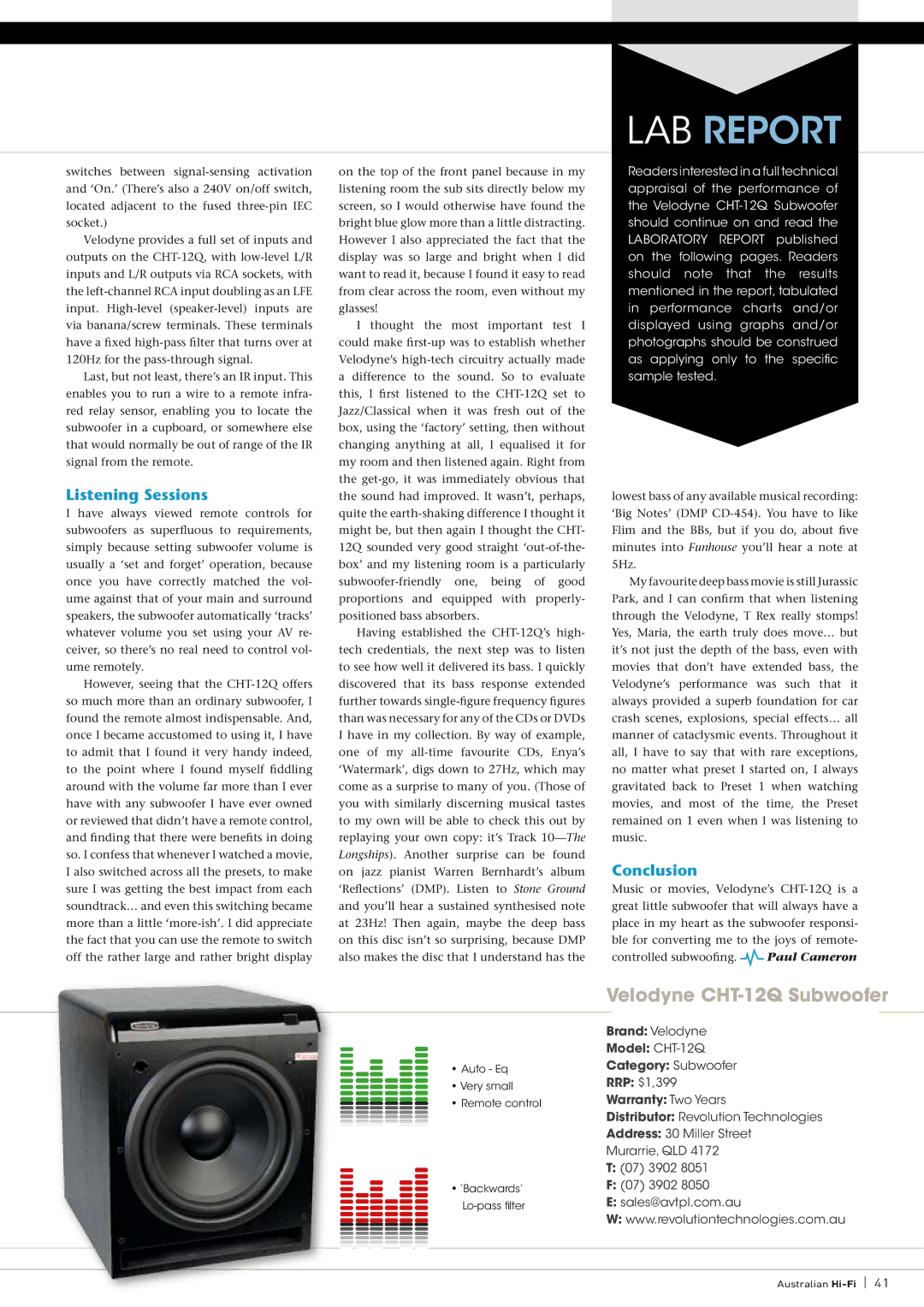switches between signal-sensing activation and ‘On.’ (There’s also a 240V on/off switch, located adjacent to the fused three-pin IEC socket.)
Velodyne provides a full set of inputs and outputs on the CHT-12Q, with low-level L/R inputs and L/R outputs via RCA sockets, with the left-channel RCA input doubling as an LFE input. High-level (speaker-level) inputs are via banana/screw terminals. These terminals have a fixed high-pass filter that turns over at 120Hz for the pass-through signal.
Last, but not least, there’s an IR input. This enables you to run a wire to a remote infra- red relay sensor, enabling you to locate the subwoofer in a cupboard, or somewhere else that would normally be out of range of the IR signal from the remote.
Listening Sessions
I have always viewed remote controls for subwoofers as superfluous to requirements, simply because setting subwoofer volume is usually a ‘set and forget’ operation, because once you have correctly matched the vol- ume against that of your main and surround speakers, the subwoofer automatically ‘tracks’ whatever volume you set using your AV re- ceiver, so there’s no real need to control vol- ume remotely.
However, seeing that the CHT-12Q offers so much more than an ordinary subwoofer, I found the remote almost indispensable. And, once I became accustomed to using it, I have to admit that I found it very handy indeed, to the point where I found myself fiddling around with the volume far more than I ever have with any subwoofer I have ever owned or reviewed that didn’t have a remote control, and finding that there were benefits in doing so. I confess that whenever I watched a movie, I also switched across all the presets, to make sure I was getting the best impact from each soundtrack… and even this switching became more than a little ‘more-ish’. I did appreciate the fact that you can use the remote to switch off the rather large and rather bright display
on the top of the front panel because in my listening room the sub sits directly below my screen, so I would otherwise have found the bright blue glow more than a little distracting. However I also appreciated the fact that the display was so large and bright when I did want to read it, because I found it easy to read from clear across the room, even without my glasses!
I thought the most important test I could make first-up was to establish whether Velodyne’s high-tech circuitry actually made a difference to the sound. So to evaluate this, I first listened to the CHT-12Q set to Jazz/Classical when it was fresh out of the box, using the ‘factory’ setting, then without changing anything at all, I equalised it for my room and then listened again. Right from the get-go, it was immediately obvious that the sound had improved. It wasn’t, perhaps, quite the earth-shaking difference I thought it might be, but then again I thought the CHT- 12Q sounded very good straight ‘out-of-the- box’ and my listening room is a particularly subwoofer-friendly one, being of good proportions and equipped with properly- positioned bass absorbers.
Having established the CHT-12Q’s high- tech credentials, the next step was to listen to see how well it delivered its bass. I quickly discovered that its bass response extended further towards single-figure frequency figures than was necessary for any of the CDs or DVDs I have in my collection. By way of example, one of my all-time favourite CDs, Enya’s ‘Watermark’, digs down to 27Hz, which may come as a surprise to many of you. (Those of you with similarly discerning musical tastes to my own will be able to check this out by replaying your own copy: it’s Track 10—The Longships). Another surprise can be found on jazz pianist Warren Bernhardt’s album ‘Reflections’ (DMP). Listen to Stone Ground and you’ll hear a sustained synthesised note at 23Hz! Then again, maybe the deep bass on this disc isn’t so surprising, because DMP also makes the disc that I understand has the
LAB REPORT
Readers interested in a full technical appraisal of the performance of the Velodyne CHT-12Q Subwoofer should continue on and read the LABORATORY REPORT published on the following pages. Readers should note that the results mentioned in the report, tabulated in performance charts and/or displayed using graphs and/or photographs should be construed as applying only to the specific sample tested.
lowest bass of any available musical recording: ‘Big Notes’ (DMP CD-454). You have to like Flim and the BBs, but if you do, about five minutes into Funhouse you’ll hear a note at 5Hz.
My favourite deep bass movie is still Jurassic Park, and I can confirm that when listening through the Velodyne, T Rex really stomps! Yes, Maria, the earth truly does move… but it’s not just the depth of the bass, even with movies that don’t have extended bass, the Velodyne’s performance was such that it always provided a superb foundation for car crash scenes, explosions, special effects… all manner of cataclysmic events. Throughout it all, I have to say that with rare exceptions, no matter what preset I started on, I always gravitated back to Preset 1 when watching movies, and most of the time, the Preset remained on 1 even when I was listening to music.
Conclusion
Music or movies, Velodyne’s CHT-12Q is a great little subwoofer that will always have a place in my heart as the subwoofer responsi- ble for converting me to the joys of remote-
controlled subwoofing. Paul Cameron
Paul Cameron

